#adam tendler
Text
Good story about a pianist’s relationship with his father and how it sparked a program of newly commissioned work by top contemporary classical composers.
2 notes
·
View notes
Link
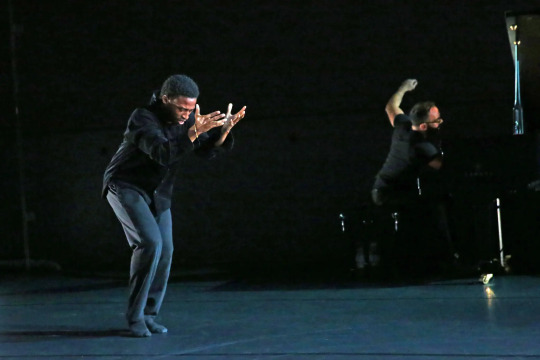
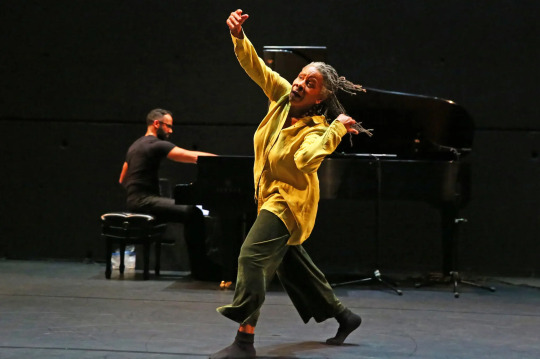
Adam Tendler at the piano, with dancers Matthew Johnson and Bebe Miller
2 notes
·
View notes
Text
Julius Eastman marathon at 92nd Street Y
Last weekend was the Julius Eastman marathon. Friday night, Saturday afternoon and Saturday evening. Eastman is finally getting his due, which is fantastic, especially since I find him a lot more enjoyable than some of the modernists he was hanging out with at the time. (One of the other modernists was Petr Kotik as the SEM Ensemble was being founded. Over time, I’ve found Kotik to have squeezed every last breath of emotion out of his modernist pieces -- all intellect and nothing else.)
Friday evening was Femenine, which seems to be his most famous piece -- I have two recent recordings and there are others. Like most of Eastman’s work, there isn’t a full score here. Mostly the foundations of a performance -- a repetitive vibraphone phrase, repeated endlessly. (Think like an advanced version of In C’s pulse.) And tons of bells, played repetitively (hypnotically, like a ritual). And individual phrases given to various performers, but I don’t think any of it is specifically notated.
Femenine may be so popular, because the foundation is graspable, but it still leaves room for the performers to create a ritual space in which to play. How much is improvised/arranged isn’t clear, but the elements that are given seem to be enough to create a moment, which is presumably what Eastman wanted.
Saturday afternoon was several smaller pieces, including Evil N---, played by Adam Tendler and Devonté Hynes and the rest of the ensemble. Talked to Adam Friday night and a bit on Saturday night. Evil is a pounding piece, exploding in a way I haven’t quite determined. Not as angry as I’ve heard Rzewski’s Coming Together -- given the title, one might expect more raw anger. Not rhythmically or harmonically adventurous as other music I often listen to, being based again on certain repetitive motifs. Exciting to see in performance. And the quieter piano pieces showed a different side of Eastman that was quite beautiful.
Least successful to me was Saturday night’s Buddha. The program notes make reference to the score/piece as a process wrapped up in an egg, but this made no sense until Adam showed me his picture of the score (a single handwritten page without about two rows of note designations wrapped up in an egg shape). Being egg shaped, the middle rows had more notes than the beginning or end ones. So it was another constructed piece, but with so little to ground it that it just felt meanderingly long. Performers come and go, play their notes for a while (presumably repeating phrases ad libitum and the move on to the next row in the score), and then leave. It was intended to last 5 hours. The entry of individual performers were timed (again from Adam), but the overall structure just seemed to float from performer to performer. I stayed until he came on, but then ultimately left about halfway through.
I thought a lot about In C during Buddha. When I first saw In C it was live and the score was printed in the program notes, as well as an explanation of the pulse, though the pulse was in that instance only going to be played sometimes as a nostalgic call-back, since performers now don’t strictly need the pulse to keep on track. Somehow this presentation of the raw materials gave a sense of the transformation of materials that we were experiencing -- all this beauty and joy and life from just this couple pages of instruction. It made us think about what a composer is, and isn’t -- why with this much more free form structure does it still sound like Riley? Just like in theater at it’s best, sometimes seeing the raw materials that the the magic is made of only enhances the magical effect.
And this was what was sometimes missing from Buddha, which seemed very amorphous. The bar was getting more and more crowded as I left (we were encouraged to float freely from the bar to the auditorium, etc.). I’m not sure what effect I would have gained by staying. There is a fine line between hypnotic and monotonous, and it seemed to be crossing over that line.
All praise to the musicians of Wild Up and especially the dynamic conducting/leading by Richard Rountree.
0 notes
Text
Wild Up Announce New Recording of Julius Eastman’s If You’re So Smart, Why Aren’t You Rich?
The Los Angeles music collective Wild Up have announced the third installment of their seven-volume anthology celebrating the work of late composer Julius Eastman. Following 2021’s recording of Femenine and 2022’s Joy Boy, Julius Eastman, Vol. 3: If You’re So Smart, Why Aren’t You Rich? is out June 16 via New Amsterdam. Blood Orange’s Devonté Hynes and Adam Tendler both appear on the new album.…

View On WordPress
0 notes
Text
Wild Up Announce New Recording of Julius Eastman’s If You’re So Smart, Why Aren’t You Rich?
The third volume in the collective’s ongoing series features Blood Orange’s Devonté Hynes and Adam Tendler
from RSS: News https://ift.tt/DHCaRJ6
0 notes
Text
Wild Up Announce New Recording of Julius Eastman’s If You’re So Smart, Why Aren’t You Rich?
The third volume in the collective’s ongoing series features Blood Orange’s Devonté Hynes and Adam Tendler
from RSS: News https://ift.tt/wS4He0l
via IFTTT
0 notes
Text
92NY presents Wild Up: Radical Adornment The Music of Julius Eastman with Special Guests Devonté Hynes and Adam Tendler
The 92nd Street Y, New York (92NY), one of New York’s leading cultural venues, presents Wild Up performing Radical Adornment: The Music of Julius Eastman with special guests Devonté Hynes and Adam Tendler on April 21 & 22, 2023. Tickets start at $25 and are available at 92ny.org/event/wild-up-plays-julius-eastman.
The extraordinary music of Black, gay experimental composer Julius Eastman…
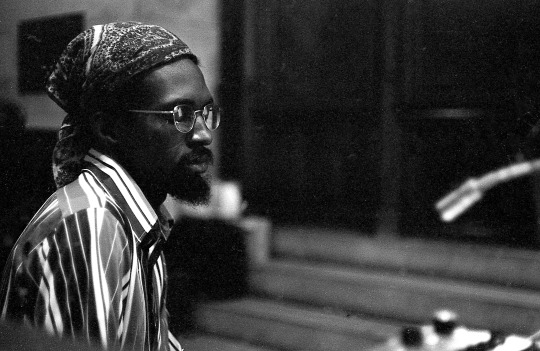
View On WordPress
0 notes
Text
Sō Percussion, MEDIAQUEER, Adam Tendler, Alex Sopp, Beth Meyers, Shelley Washington, Grey Mcmurray — Stay On It (So Percussion Editions)

Stay On It by Sō Percussion, MEDIAQUEER, Adam Tendler, Alex Sopp, Beth Meyers, Shelley Washington, Grey Mcmurray
Even if the music was only a fraction as interesting, the process by which this recording of composer Julius Eastman’s 1973 Stay On It was made would be compelling on its own. As the ensemble described it, the renewed interest in Eastman’s work prompted them to seek out one of his works; this particular recording was made by the quartet together, than bolstered by additional contributions recorded remotely by musicians like yMusic’s Alex Sopp and the flute/electronics duo MEDIAQUEER.
Talented artists, all. But what makes this recording of Stay On It click as well as it does is the extent to which it doesn’t feel like a work assembled piecemeal. Had the recording notes not mentioned the remote contributions, it would be easy to believe that this was recorded live, so well do the musicians mesh. To the extent that any one element feels disassociated from the rest, it’s the use of multiple vocalists singing the title of the composition — but given that the effect here evokes tape loops going slightly out of sync, that sense of distance works perfectly well in context.
The overall mood here is one of buoyant minimalism, and for the first third of the piece, a steady rhythm with a few nimble permutations endures. At just over nine minutes in, the disparate instruments that have been playing along converge, and the effect is something that swings magnificently, with Sopp’s woodwind work making an especially forceful impact. From there, the composition takes on a more staggered approach, incorporating occasional breaks along with precise stops and starts that would make an average post-punk band blush — and it’s not long before the music turns more atonal and the blissed-out vocals take on a harsher quality.
The final third of the piece takes on a sparser mood, with strings continuing the melody even as the percussion fades into the backdrop. The effect is sprawling, with moments echoing the more cosmic rock music emerging from recording studios and concert halls at the same time Eastman was composing this. Can a piece of music be both elegiac and ecstatic? This recording answers in the affirmative.
Tobias Carroll
#Sō Percussion#MEDIAQUEER#Adam Tendler#alex sopp#beth meyers#shelley washington#grey mcmurray#stay on it#tobias carroll#albumreview#dusted magazine#julius eastman
2 notes
·
View notes
Text
.
#the John mulaney Anna tendler news has floored me#like they were so good together and so cute#the last shreds of true love are breaking down#the only relationship left is Adam and Joanne#I swear to god
4 notes
·
View notes
Text
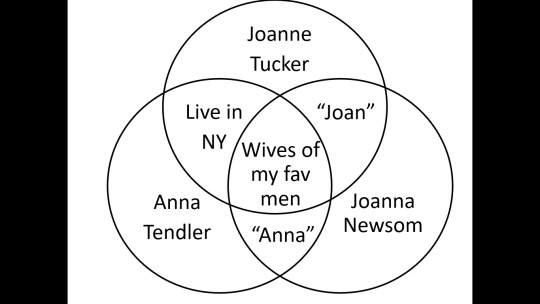
i made a thing, i guess?
#venn diagram#joanne tucker#adam driver#anna tendler#John Mulaney#joanna newsom#andy samberg#annamarie tendler#annamarie tendler mulaney
15 notes
·
View notes
Text
Premios Oscar 2019 I
Premios Oscar 2019 I
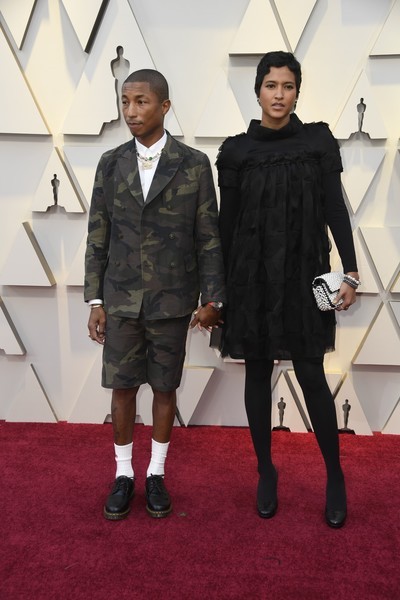
Anoche se celebró la 91 edición de los Premios Oscar. La Academia de cine entregó sus premios, como siempre, en el Dolby Theatre de Hollywood. Se que estos días, desde mi cumpleaños, el pasado martes, he estado desaparecida. Pero ya retomo el blog a ritmo normal, pasados los Oscar y sus fiestas volveremos a los desfiles. En el siguiente post hablaremos de los ganadores, ahora toca comenzar el…
View On WordPress
#adam driver#adrian original#alberta ferretti#alexnadra byrne#alicia malone#alta costura#amatus sami-karim#amy poehler#anita casali#annamarie tendler#annie starke#ariane labed#august getty atelier#awkwafina#azza fahmy#barbra streisand#becky willmott#beth miller#bette midler#brandon maxwell#burnett#catilin feige#ceci dempsey#chelsea peretti#chopard#christian louboutin#christian siriano#danielle macdonald#david rawlings#dawn hudson
1 note
·
View note
Photo
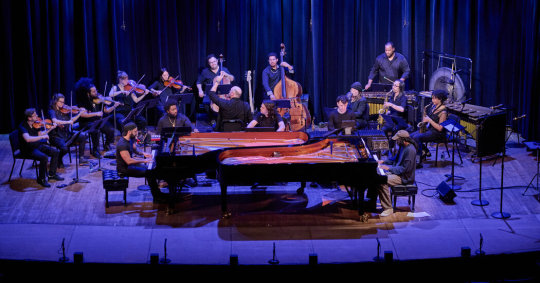
Adam Tendler and Devonté Hynes at the pianos with the ensemble Wild Up
(via Now Celebrated, Julius Eastman’s Music Points to a New Canon - The New York Times)
1 note
·
View note
Text
FILMES E DOCUMENTARIOS PARA TEMPOS DE QUARENTENA
ORGANIZADOS PELO Portal https://marxismo21.org/
I. Filmes, documentários e entrevistas de dirigentes, lideranças e intelectuais de esquerda (marxistas ou progressistas)
A idade do século – voz e rosto de Gregório Bezerra, dirigido por Geneton de Moraes Neto (1986), https://www.youtube.com/watch?v=fjWtQTEgdfk&t=9s
A resistência final de Salvador Allende, dirigido por Patricio Henriquez (1998) – legendado em português, https://www.youtube.com/watch?v=PHaXSUVPRw0
Alexandra Kollontai, produzido por BBC – áudio em castelhano, https://www.youtube.com/watch?v=f5UvZ0eHVx4
Álvaro Cunhal – A Vida de Um Resistente. 1ª Parte – Que Fazer, dirigido por Joaquim Vieira (2006), https://www.youtube.com/watch?v=6B0Rd2EWi84
Álvaro Cunhal – A Vida de Um Resistente. 2ª Parte – O Estado e a revolução, dirigido por Joaquim Vieira (2006), https://www.youtube.com/watch?v=8_aaVtk9hFk
Álvaro Cunhal – percursos, produzido por TVI (1995), https://www.youtube.com/watch?v=4fMd53DXFkk
Amílcar Cabral: vida e morte, dirigido por Antonio de Deus Gonçalves (2009), https://www.youtube.com/watch?v=_SriEOeFn_E&feature=youtu.be
Antonio Gramsci, os dias do cárcere, dirigido por Lino del Fra (1977) – legendado em português, https://www.youtube.com/watch?v=AkIqn4VqkdQ
Africa’s Black Star: the rise and fall of Kwame Nkrumah, dirigido por Nuakai Tehuti Aru – aúdio em inglês, https://www.youtube.com/watch?time_continue=9&v=2qazB9d-csg&feature=emb_logo
Biografía Josip Broz Tito, https://www.youtube.com/watch?v=cKzFbeiE5pA&t=2221s
Black Power – The Kwame Nkrumah Documentary, dirigido por Adam Curis (1992) – áudio em inglês, https://www.youtube.com/watch?v=xK9xi1L0USk&feature=youtu.be
Cabra marcado pra morrer, dirigido por Eduardo Coutinho (1984), https://www.youtube.com/watch?v=s7pnKjA56-g
Cadê Zé Profiro?, dirigido por Hélio Brito (2004), https://www.youtube.com/watch?v=7A8WN4LI8jw&feature=youtu.be
Carlos el amanecer dejó de ser una tentación, dirigido por Marjorie Arostegui(2012) – áudio em castelhano,https://www.youtube.com/watch?v=GLdq5H-K-ic
Camilo Torres, el cura guerrillero, dirigido por Francisco Norden (1974) – legendado em castelhano,https://www.youtube.com/watch?v=tcndMqiKURQ&feature=youtu.be
Carlos Eugênio Paz, Comandante Clemente – entrevista a Geneton Moraes Neto, GloboNews, https://www.youtube.com/watch?v=gZ9aKnRz0Qc
Celia Sánchez, produzido por Mundo Latino (2016) – áudio em castelhano, https://www.youtube.com/watch?v=ifHfkBnoLSM
Che Guevara donde nunca jamás se lo imaginan, dirigido por Manuel Pérez Paredes (2004) – áudio em castelhano, https://www.youtube.com/watch?v=6QfuOOJzByg&feature=emb_logo
Chico Mendes, a Voz da Amazônia, dirigido por Miranda Smith (1989), https://www.youtube.com/watch?v=GXaxJYf9IPI&feature=youtu.be
Diários de motocicleta, dirigido por Walter Salles (2004), https://www.youtube.com/watch?v=IvuDnj_K_Q8
Elisa Branco, a corajosa comunista da luta mundial pela paz, https://www.youtube.com/watch?v=18nmruwnQeo
El Diálogo de América – una conversación entre Fidel Castro y Salvador Allende (1971) – áudio em castelhano, https://www.youtube.com/watch?v=BLoIwfSV0PY
Entrevista com Domenico Losurdo com Giulio Gerosa – 12 partes (2011) – legendado em português, https://www.youtube.com/watch?v=QWKDx8siO0Q&list=PL60F1441D2932F663
Farabundo Martí, Alma y corazón, produzido por Secretaría de Comunicaciones del Frente Farabundo Marti para la Liberación Nacional (FMLN) (2017) – legendado em castelhano, https://www.youtube.com/watch?v=1qXKE17NKZM
Florestan Fernandes – o mestre, dirigido por Roberto Stefanelli (2004), https://www.youtube.com/watch?v=ncGSS2yyhNw
Florestan Fernandes – Programa da Vox Populi (1984), https://www.youtube.com/watch?v=dPAYUfcwR0E
Francisco Julião, na lei ou na marra, dirigido por Clarisse Viana e Fernando Barcellos (2016), https://www.youtube.com/watch?v=43n2sfBy0Ho&feature=youtu.be
Giap – Memórias Centenárias da Resistência, dirigido por Sílvio Tendler (2003) – legendado em português, https://www.youtube.com/watch?v=Tq8c72PKSCA
Gregório Bezerra – uma entrevista histórica, dirigido por Luiz Alberto Sanz, Lars Safstrom, Leonardo Cespedes e Staffan Lindqvist (1976), https://www.youtube.com/watch?v=4pWsSnmFYaY&t=85s
Herbert Marcuse interview with Bryan Magee (1977) – áudio em inglês, https://www.youtube.com/watch?v=0KqC1lTAJx4
Ho Chi Minh y la independencia de Vietnam,https://www.youtube.com/watch?v=cz7A_icksHA
Interview with Georg Lukacs – legendado em inglês,https://www.youtube.com/watch?v=9OUTlByL-44
José Carlos Mariátegui: Serie Maestros de América Latina, – áudio em castelhano, https://www.youtube.com/watch?v=OylJbxm0x_o
Karl Marx por Louis Althusser e Émile Bottigelli, produzido por France Culture (1963) – áudio em francês, https://www.youtube.com/watch?v=0_0JcAmZ5U0&t=309s
La Guerra Necesaria: Fidel Castro, dirigido por Santiago Alvarez (1980)– áudio em castelhano, https://www.youtube.com/watch?v=h3tOpj6ntCI
Lenin em Outubro, dirigido por Mikhail Romm (1937) – legendado em castelhano, https://www.youtube.com/watch?v=pl6ydldxNKg
Lumumba, dirigido por Raoul Peck (2000) – áudio em francês, https://youtu.be/SZEGI5kEsBo
Marighella, dirigido por Isa Grinspum Ferraz (2012), https://www.youtube.com/watch?v=7Mw386dVhcY&t=4s
Marighella, O retrato falado do guerrilheiro, dirigido por Silvio Tendler (2001), https://www.youtube.com/watch?v=Y8otiuMrzsQ
Nicos Poulantzas, diez años de ausencia, dirigido por Nikos Jurakis y Kostas Jristópoulos (1989) – legendado em castelhano,https://www.youtube.com/watch?v=mchAHtQgUL8&t=151s
Nova África: Agostinho Neto, dirigido por Mônica Monteiro, https://www.youtube.com/watch?v=paPozP7IVjs
O assassinato de Trotsky, dirigido por Joseph Losey (1972) – legendado em português,https://www.youtube.com/watch?v=OLK6C6ekS-8&feature=youtu.be
O jovem Karl Marx, dirigido por Raoul Peck (2017) – legendado em português,https://www.youtube.com/watch?v=2M5vo2n6G7Y&t=1446s
O mestre Graça, dirigido por Jorge Oliveira (1986), https://www.youtube.com/watch?v=JlqbVfhydz0&feature=youtu.be
O sonho de Rose: 10 anos depois, dirigido por Tetê Moraes (2000), https://www.youtube.com/watch?v=xP2Jm23RJ9Y&t=4s
O velho: a história de Luiz Carlos Prestes, dirigido por Toni Venturi (1997), https://www.youtube.com/watch?v=1u02uqMK6Ek
Rio Chiquito (Homenagem a Hernando González Acosta), dirigido por Bruno Munuel e Jean Pierre Sergent (1965) – áudio em castelhano, https://www.youtube.com/watch?v=3DMePi_I_1M&feature=youtu.be
Rosa Luxemburgo, dirigido por Margarethe von Trotta (1986) – legendado em português, https://www.youtube.com/watch?v=qu96jHjkEsY
Samora Vive, dirigido por Filomena Salvador (2011), https://www.youtube.com/watch?v=7j6vo1NLgCQ
Sandino, dirigido por Miguel Littin (1990) – áudio e legenda em castelhano, https://www.youtube.com/watch?v=mblNOkimp6I
Simplemente Camilo, produzido por Mundo Latino (2009) – áudio em castelhano, https://www.youtube.com/watch?v=A6cUm786-Aw
Terra para Rose, dirigido por Tetê Moraes (1987), https://www.youtube.com/watch?v=1ZlqjK4K1-0
Thomas Sankara. “…e naquele dia mataram a felicidade”, dirigido por Silvestro Montanaro (2013) – em português, https://www.youtube.com/watch?v=20u-WWjM_50
Tosco, dirigido por Adrián Jaime (2011) – áudio e legenda em castelhano, https://www.youtube.com/watch?v=JcN05ceUk5A&feature=youtu.be
Três Canções Para Lênin, dirigido por Dziga Vertov (1934) – em português, https://www.youtube.com/watch?v=WFuvUO1riIM&feature=emb_logo
Vale a pena sonhar: a vida de Apolônio de Carvalho, dirigido por Stela Grisotti e Rudi Böhm (2003), https://www.youtube.com/watch?v=23ptxXE-oSY&feature=youtu.be
II. Documentários e filmes sobre o nazismo e o fascismo
Arquitetura da destruição, Diretor Peter Cohen (1989), https://www.youtube.com/watch?v=BZq4VC6uIPk&t=2227s
Fascism Inc, Diretor Aris Chatzistefanou (2014), https://www.youtube.com/watch?v=K80XYjF3lHE
O fascismo de todos os dias, Diretor Mikhail Romm (1965) – legendas em português, https://archive.org/details/FascismodeTodosOsDias1965
El fascismo cotidiano (= O fascismo de todos os dias), Diretor Mikhail Romm (1965) – legendas em castelhano, https://www.youtube.com/watch?v=7WgB2sulSuo
II, Filmes sobre nazismo e fascismo:
A língua das mariposas
A onda, Diretor Dennis Gansel (2008) – dublado, https://www.youtube.com/watch?v=zG3TfjAhs30
A queda – as últimas horas de Hitler, Diretor Oliver Hirschbiegel (2005) – dublado, https://www.youtube.com/watch?v=qQ-oF2OLYGw
Chá com Mussolini, Diretor Franco Zeffirelli (2000) – legendas em português, https://www.youtube.com/watch?v=SI15yEq7i-o&t=2773s
Isto é Inglaterra, Diretor Shane Meadows (2009) – legendado em português, https://www.youtube.com/watch?v=tzh9CzwJuc0&feature=youtu.be
O anjo de Auschwitz , Diretor Terry Lee Cooker (2019) – dublado, https://www.youtube.com/watch?v=ENvwRXE106s
Os deuses malditos, Diretor Luchino Visconti (1969) – versão original em italiano, https://www.youtube.com/watch?v=9J8PAQ5Wwak&t=11s
O jardim dos Finzi-Contini, Diretor Vittorio de Sica (1970) – legenda em inglês, https://www.youtube.com/watch?v=PxSPu25xbQw
O ovo da serpente, Diretor Ingmar Bergman (1977) – legendas em português, https://www.youtube.com/watch?v=M0WqyFnNsiE
O refúgio secreto, Diretor James F. Collier (1975) – legendas em português, https://www.youtube.com/watch?v=sRaGkWbMR9E
O triunfo da vontade, Diretor Leni Riefenstahl (1935) – legenda em inglês, https://www.youtube.com/watch?v=s8bJ1W2aKy0&t=813s
Riphagen, Diretor Pieter Kuijpers (2016) – dublado, https://www.youtube.com/watch?v=iJ5XRxK0stM
Roma, cidade aberta, Diretor Roberto Rosselini (1945) – legendas em português, https://www.youtube.com/watch?v=gcRbKX2MeFo
Trens estreitamente vigiados, Diretor Jiří Menzel (1966) – legendas em português, https://www.youtube.com/watch?v=PUMaCeyupoA
Um skinhead no divã, Diretor Niklas Rådström e Suzanne Osten (1993) – legendas em português, https://www.youtube.com/watch?v=oELvg0awEEE&feature=youtu.be
Uma cidade sem passado, Diretor Mark Verhoeven (1990) – legendas em português, https://www.youtube.com/watch?v=kKiykbMCtRM
2 notes
·
View notes
Text
Adam Driver talking about how his wife will audibly boo him if she doesn’t think he’s doing his best and Seth Meyers saying his wife will give him a look™️ is BIG John Mulaney and Annamarie Tendler mood
128 notes
·
View notes
Text
PS21 Announces First-Ever Spring Season and Executive Director
PS21 Announces First-Ever Spring Season and Executive Director
Who: More than 120 Artists from the US and five countries
What: Music, Dance, and Theater, plus residencies and workshops open to the community
Where: Performance Spaces for the 21st Century, 2980 NY Route 66, Chatham, NY 12037
When: March – November 2020
From March to November 2020 PS21will offer more programs than ever before to bring cultural and educational enrichment to the Hudson Valley’s…
View On WordPress
#3 RITES: Liberty#A Leaning Man#Adam Tendler#Ariadna Peya#Artways#Chatham NY#Clara and Ariadna Peya#Clara Peva#Compagnie Les Hommes Penchés#Conrad Tao#Contemporary Dance Makers#Contemporary Dance Makers/ Encounters with the Piano#Contemporary Flamenco Mini-Festival#Contemporary Flamenco: Art Resistance and Gender#Crellin Park#DELIRIOUS Dances#DELIRIOUS Dances/Edisa Weeks#Desplante#Edisa Weeks#Eduardo Guerrero#El Bulli#Elena Siyanko#Envá#Fabrizio Cassol#Hilary Clark#Instable#Jamal Jackson Dance Company#Jim Fletcher#Judy Grunberg#Judy Grunberg Memorial Gala
0 notes
Text
MERCE CUNNINGHAM CENTENNIAL CELEBRATION
The Merce Cunningham centennial celebration reached a peak during this week of his birthday, April 16th, with two of the major events of the celebration – “Night of 100 Solos,” happening live at London’s Barbican Theatre, New York’s BAM Opera House, and UCLA’s Royce Hall; In addition, a program of Cunningham dances done by three different companies at the Joyce Theater, April 17-21 – a feast of Cunningham dancing, done entirely by dancers who never danced in his company.

NIGHT OF 100 SOLOS. (l-r): Reid Bartelme, David Norsworthy, Sara Mearns
On Tuesday night the Howard Gilman Opera House at BAM came alive with a 90-minute “event” comprising solos extracted from Cunningham’s six-decade-long dance repertory. Twenty-five dancers ranging in age from a college student to nearly seventy-years old, present and former members of companies like Martha Graham, Mark Morris, Trisha Brown, Bill T Jones/Arnie Zane Dance Companies, Kyle Abraham’s A.I.M., New York City Ballet, and Charlotte Ballet, among others, took part. Each dancer was taught a number of solos – four it seems – by nearly two-dozen former Cunningham dancers, many of whom are now official stagers of his work.

NIGHT OF 100 SOLOS. Kyle Abraham
What emerged from this panoply of movement was recognition of the astonishing inventiveness of Cunningham’s movement and the clarity of performance it mandates. The dancers, one and all, evinced their respect and admiration for the work and its creator with near flawless embrace of his uniquely exposed style, technical execution, and kinetic spirit. Here in New York, the passages were arranged in space and time by Trish Lent, director of licensing for the Cunningham Trust, and assistant stager Jean Freebury, with simultaneous and overlapping soloists, weaving their individual pathways around each other on the large BAM stage. Sometimes spatial proximity suggested contact between them – a hand on a shoulder, a mutual focus, a conjunction of leaps or turns or balances that became accidental duets, trios, and quartets.

NIGHT OF 100 SOLOS. (l-r): Lindsey Jones, Christian Allen
Another refreshing aspect of the presentation was the diversity of bodies, training backgrounds, and, especially, races of the dancers onstage, many of whom are audience favorites in their home companies. It has been a concern that Cunningham had only four African-American men and no women in the six-decade history of his company. In my opinion (as the first of those four men) it was because Merce loved jumping for himself and his men, and his vision of the ideal female dancer was Carolyn Brown, whose perfect lines and articulation were ballet-worthy. Certainly, had he lived further into his nineties African-American women would have been invited into the troupe.
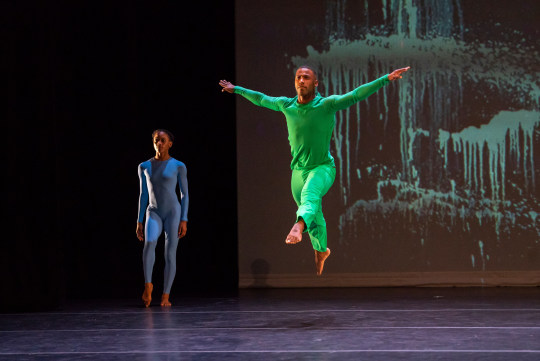
NIGHT OF 100 SOLOS. (l-r): Jaquelin Harris, Claude “CJ” Johnson.
Tuesday night, Shayla-Vie Jenkins, Tamisha Guy, Jaquelin Harris, sterling dancers and women of color proved their mastery of the style, and Kyle Abraham, Claude “CJ” Johnson, Christian Allen, and Chalvar Monteiro, evinced all the balance, articulation, and power of any of Cunningham’s alumni. Vicky Shick, one of Trisha Brown’s original company, and Keith Sabado, long-time Mark Morris dancer – both in their sixties – extended the age range we’ve come to associate with Merce’s dancers, except for himself.

NIGHT OF 100 SOLOS. The company in John Cage’s 4′33″
There was a full-company teaser ending, in which the dancers filled the stage for Cage’s “4’33”,” a silent work for piano in three movements. Light changes indicated the ends of sections, when the dancers shifted poses. There was humor – Jason Collins jumping with tin cans strapped to his loins and Sabado’s circling the stage on a bicycle, which Merce did in “Variations V.” For Cunningham aficionados it was fun to try to recall the sources of the excerpts and remember the dancers who had done them originally and succeeded them in various generations.
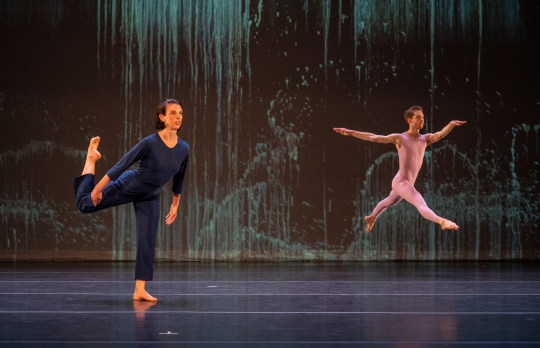
NIGHT OF 100 SOLOS. (l-r): Cecily Campbell, Jason Collins
The décor was a digital art work created by Pat Steir, which kept the cyclorama morphing slowly in white and gray images that looked like ghostly stone columns or precipitation – rain, snow, sleet – or cascading waterfalls. Lighting designer Christine Shallenberg provided an appropriately celebratory atmosphere. Reid Bartelme, who also performed, and his costume design partner dressed the dancers in wonderful pastels and richly-hued leotards, unitards, bike-tards, and jumpsuits with various necklines and sleeve lengths. Bartelme and Sarah Mearns, both in pale lavender, shared the stage at one point, doing solos at the same time.

NIGHT OF 100 SOLOS. Keith Sabado
A thunderous standing ovation greeted the dancers at the end, from an audience who felt reassured that Cunningham’s works are in good hands. Although the technical skill and precision Cunningham’s work required were ahead of their time in the last century, they are by now within the grasp of most present-day elite dancers, hence the Cunningham legacy of dance excellence seems assured for generations to come.
photos by Stephanie Berger
***************************
The following evening, April 17, the centennial celebration continues with a program at the Joyce of three Cunningham dances done by three companies – Centre National de Danse Contemporaine in Angers, directed by Cunningham’s associate director Robert Swinston; Ballet West from Salt Lake City, directed by Joffrey Ballet alumnus Adam Sklute; and Washington Ballet from D.C., directed by long-time ABT principal Julie Kent – doing, respectively “Suite for Five” (1956), “Summerspace” (1958), and “Duets” (1980).
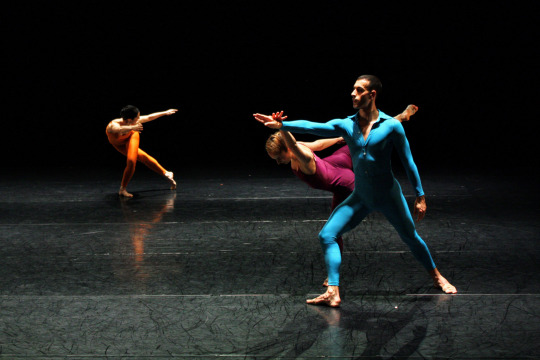
CENTRE DE DANSE CONTEMPORAINE ANGERS.(l-r): Claire Seigle-Goujon, Anna Chirescu, and Carlo Schiavo in SUITE FOR FIVE. photo by Arnaud Hie
“Suite for Five” doles itself out sparingly to a minimal piano score by John Cage, “Music for Piano,” played live by Adam Tendler. It starts with a solo, danced by Carlo Schiavo in blue tights and matching polo-neck shirt has unmistakable Cunningham signature moves like backwards walks in parallel, big jumps with open, bent legs, and low-slung crouches. Next, Catarina Pernão in bright yellow epitomizes Cunningham’s ideal female, linear and erect with balletic articulation of legs and feet, and calm balances on a foot while the other leg sweeps in long extensions that arc slowly around the body.

CENTRE DE DANSE CONTEMPORAINE ANGERS.(l-r): Gianni Joseph, Carlo Schiavo, Claire Siegle-Goujin, Catarina Pernão, and Anna Chirescu in SUITE FOR FIVE. photo Arnaud Hie
Then follows a trio by the other two women, Anna Chirescu, and Claire Seigle-Goujon, in orange and purple and Gianni Joseph in lime green. Brief blackouts separate the sections, so each is a kinetic haiku. The dance contains Cunningham signatures – long, slow balances, bursts of leaping that switch direction midair, deep lunges, male-female duets, straight from the ballet lexicon but designed with unusual shapes and leverages. This was the company’s premiere performance of the dance, and because Cunningham movement is so exposed with nowhere to hide, the dancers’ nervousness showed.

CENTRE DE DANSE CONTEMPORAINE ANGERS. (l-r): Gianni Joseph, Claire Seigle-Goujon, and Anna Chirescu in SUITE FOR FIVE. photo by Arnaud Hie

BALLET WEST. Joshua Whitehead in SUMMERSPACE. photo by Beau Pearson
“Summerspace” (1958) lends itself to performance by ballet dancers. In it, Cunningham was exploring ways of conquering various kinds of turning modern dancers weren’t used to. In 1966, it may have been the first of his dances set on the New York City Ballet. Salt Lake City’s Ballet West definitely has the technical skill to pull it off, and it’s nice to see dancers of color in some of the roles. Katlyn Addison does fine with the brutally difficult crossing, originally done by Viola Farber, in which she slides one foot forward while bending the other until she is balanced sitting on the heel of the supporting leg with the leading leg stretched ahead of her, while unfolding her arms to the sides.

BALLET WEST. Gabrielle Salvatto in SUMMERSPACE. photo by Beau Pearson
Kyle Davis another African-American dancer hangs suspended in midair in his high-flying leaps. And Joshua Shutkind has piercing focus and dynamic sharpness in the role Cunningham created for himself. The stager, Banu Ogan, managed to communicate the evanescence of the piece, which is accompanied by Morton Feldman’s sparse “IXION” and dressed in white unitards, stippled with pastel dots by Robert Rauschenberg, that match his beautiful, pastel pointillist backdrop that camouflages the dancers, when they pose motionless in front it.
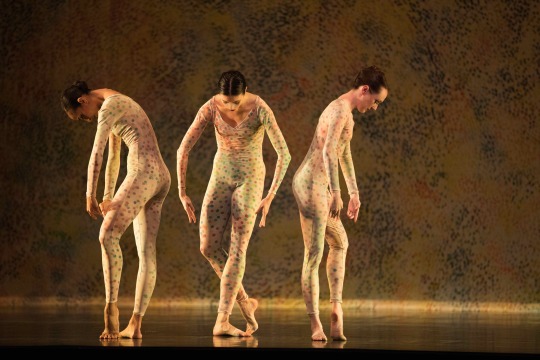
Artists of BALLET WEST in SUMMERSPACE. photo by Beau Pearson

WASHINGTON BALLET in DUETS. (l-r): Tamako Miyazaki and Alexandros Pappajohn. photo by Dean Alexander
The Washington Ballet takes on “Duets” (1980), staged sensitively by Melissa Toogood, another of the Cunningham’s dances that is well suited for the skills of a classical company. Made for six couples in Mark Lancaster’s costumes and lighting, the clothes are an amazing mixture of colors – pastel and bright – and shapes – tights, leotards, skirts, and dresses – that seem random but blend wonderfully.
The piece has moments of dry humor, when a man keeps switching the hand that holds up his partner’s raised arm in a balance, while she holds a tilted passé. And another woman alternates hands on her partner’s outstretched support arm. The dancers can also exit the stage by suddenly disappearing behind a curtain upstage that cuts off the right third of the upstage.

WASHINGTON BALLET in DUETS. (l-r): Javier Morera, Nicole Graniero, Alexandros Pappajohn, and Tamako Miyazaki. photo by Dean Alexander
The dancers overlap each other’s duets, entering or crossing the stage, as if they are continuing their duet offstage. Cunningham is showing us the portion of action that appears in the space we can see, and encourages us to imagine the parts that might be happening out of our view. Here, Cunningham’s movement does not depart radically from ballet vocabulary; it just expands it, working in parallel as well as turned out and adding some un-balletic torso action that the dancers have seemingly embraced under Toogood’s expert coaching,
(Note: some photos of companies at The Joyce may be of alternate cast members)
Gus Solomons jr, © 2019
2 notes
·
View notes